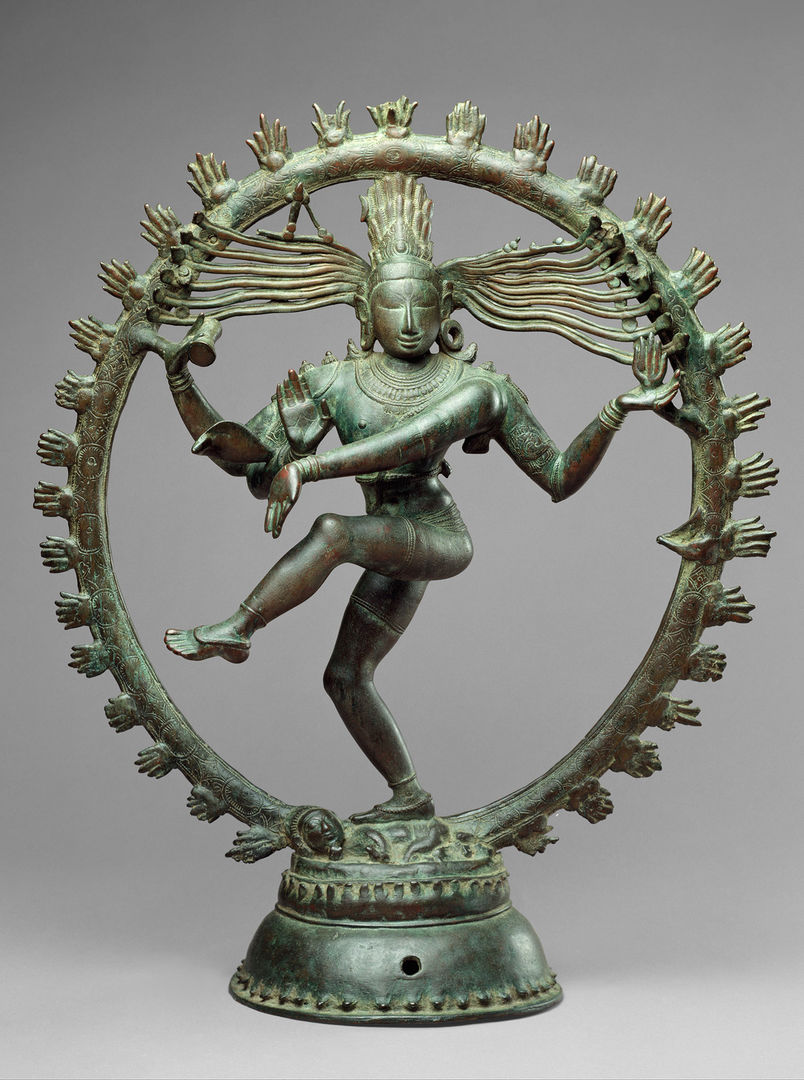Shiva—Creator, Protector, and Destroyer

Shiva as Lord of Dance (Nataraja), Chola period (880–1279), about 11th century. Tamil Nadu, India. Copper alloy, 26 7/8 x 22 1/4 in. (68.3 x 56.5 cm). The Metropolitan Museum of Art, New York, Gift of R. H. Ellsworth Ltd., in honor of Susan Dillon, 1987 (198 7.80.1)
Collection Areas: Asian Art, Indian Art, South and Southeast Asian Art
Subject Areas: English Language Arts, Visual Arts, World History
Grades: Middle School, High School
Topic/Theme: The Art of Belief
Goals
Students will be able to:
- use visual evidence to support interpretations of a work of art;
- make personal connections to works of art; and
- communicate various aspects of their lives in a self-portrait.
National Learning Standards
English Language Arts
NL-ENG.K-12.4 Communication Skills
NL-ENG.K-12.9 Multicultural Understanding
NL-ENG.K-12.12 Applying Language Skills
Visual Arts
NA-VA.K-12.1 Understanding and Applying Media Processes and Techniques
NA-VA.K-12.3 Choosing and Evaluating a Range of Subject Matter, Symbols, and Ideas
NA-VA.K-12.4 Understanding the Visual Arts in Relation to History and Cultures
World History
NSS-WH.5-12.5 Era 5: Intensified Hemispheric Interactions, 1000–1500 c.e.
Common Core State Standards
English Language Arts
CCSS.ELA-Literacy.CCRA.SL.1 Prepare for and participate effectively in a range of conversations and collaborations with diverse partners, building on others' ideas and expressing their own clearly and persuasively.
CCSS.ELA-Literacy.CCRA.SL.2 Integrate and evaluate information presented in diverse media and formats, including visually, quantitatively, and orally.
Questions for Viewing
- This sculpture presents the Hindu god Shiva as the Lord of the Dance. What do you notice about the figure’s pose? Why do you think the artist chose to capture this moment?
- Use your hands and arms to recreate the pose of the lower left and right arm. What comes to mind as you make these gestures? In Hindu art and dance, hand gestures called mudras communicate ideas to the viewer. The examples we see here are designed to allay fear (left) and offer refuge (right).
- Look closely at the accessories the figure is wearing and holding. What do you notice? What might these objects represent?
- Now that you’ve had an opportunity to consider the figure, let’s examine its context within the composition. What do you notice? What does this add to your understanding?
- The figure Shiva stands upon a dwarflike demon, who represents human ignorance and leads people astray. What aspects of daily life might distract someone from a spiritual path?
- Shiva is known as a creator, protector, and destroyer. What evidence of each role can you find in the sculpture?
Activity
Activity Setting: Classroom
Materials: Paper, pencil, paints and brushes, or clay
Subject Areas: Visual Arts
Duration: 120 minutes
Just as Shiva takes on the persona of a creator, protector, and destroyer, we often take on numerous roles throughout the day. Make a list of the various roles you engage in your daily life (e.g., student, athlete, sibling, friend) and select three or more to use as an inspiration for a self-portrait.
Resources
Dehejia, Vidya. "Hinduism and Hindu Art." In Heilbrunn Timeline of Art History. New York: The Metropolitan Museum of Art, 2000–. (February 2007)
Kossak, Steven M., and Edith W. Watts. The Art of South and Southeast Asia: A Resource for Educators. New York: The Metropolitan Museum of Art, 2001. Download the resource.
Michell, George. Hindu Art & Architecture. New York: Thames & Hudson, 2000.
"Shiva as Lord of the Dance (Nataraja) [Tamil Nadu, India] (1987.80.1)." In Heilbrunn Timeline of Art History. New York: The Metropolitan Museum of Art, 2000–. (October 2006)
Objects in the Museum's Collection Related to this Lesson
Stela with a Four-Armed Vishnu, 10th–11th century. India. Punjab. Sandstone, 43 1/2 x 25 5/8 x 10 in. (110.5 x 65.1 x 25.4 cm). The Metropolitan Museum of Art, New York, Rogers Fund, 1968 (68.46)
The Goddess Durga Killing the Buffalo Demon, Mahisha (Mahishasuramardini). Pala period, 12th century. Bangladesh or India (West Bengal). Argillite, H. 5 5/16 in. (13.5 cm). The Metropolitan Museum of Art, New York, Purchase, Diana and Arthur G. Altschul Gift, 1993 (1993.7)
Author: Claire Moore, The Metropolitan Museum of Art, 2010